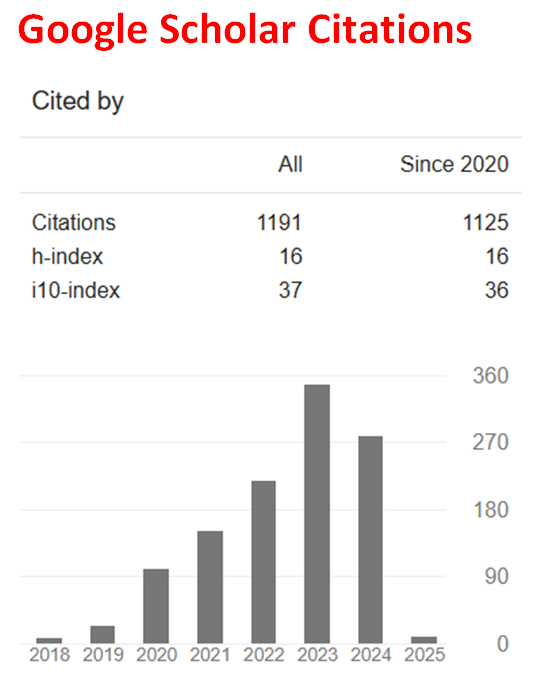Discretization of Linearized Water Waves
Abstract
The concept of linearized water wave theory is fundamental in fluid dynamics and extensively utilized for studying wave propagation in various aquatic environments. Water waves are crucial in many engineering and scientific fields like ocean and coastal engineering, ship hydrodynamics, and offshore engineering. However, the complexity of nonlinear wave dynamics has limited the accuracy of traditional numerical models, highlighting the need for a simpler yet robust approach. Linearized water wave theory offers a promising solution by assuming small-amplitude waves, which simplifies the governing equations and provides an efficient tool for wave analysis.
The numerical simulation of linearized water wave theory holds significant importance across a spectrum of engineering and scientific disciplines, spanning from coastal engineering to oceanography. This paper focuses on discretizing the Euler equation to facilitate precise and efficient numerical simulations of linearized water wave phenomena. The Euler equation, which governs the dynamics of inviscid fluid flow, undergoes linearization to simplify the mathematical formulation while preserving crucial wave dynamics. Discretization methods, including finite difference, finite element, or spectral techniques, are employed to approximate the continuous equations on a discrete computational grid. Subsequently, these discretized equations are numerically solved using iterative or time-stepping methods to forecast the evolution of water waves over time. The accuracy and stability of the numerical scheme are evaluated through convergence studies and validation against analytical solutions or experimental data.
References
Andersen, T. L., & Frigard, P. (2011). Lecture notes for the course in water wave mechanics (DCE Lecture Notes No. 24). Department of Civil Engineering, Aalborg University. Retrieved from: https://vbn.aau.dk/ws/portalfiles/portal/54776415/Lecture_Notes_for_the_Course_in_Water_Wave_Mechanics.pdf
Apsley, D. (n.d.). Hydraulics 3. Waves: Linear wave theory. Retrieved from: https://personalpages.manchester.ac.uk/staff/david.d.apsley/lectures/hydraulics3/WavesLinear.pdf
Çengel, Y. A., & Cimbala, J. M. (2013). Fluid mechanics: Fundamentals and applications. McGraw-Hill Education. Retrieved from: https://archive.org/details/ed4_20201119
Kundu, P. K., & Cohen, I. M. (2004). Fluid mechanics (3rd ed.). Elsevier Academic Press. Retrieved from: https://archive.org/details/fluidmechanics0000kund
Dean, R. G., & Dalrymple, R. A. (1984). Water wave mechanics for engineers and scientists. Prentice-Hall Inc.
Dean, R. G., & Dalrymple, R. A. (1991). Water wave mechanics for engineers and scientists. World Scientific Publishing Co. Pte Ltd. https://doi.org/10.1142/1232
Donelan, M. A., Curcic, M., Chen, S. S., & Magnusson, A. K. (2012). Modeling waves and wind stress. J. Geophys. Res., 117, C00J23. https://doi.org/10.1029/2011JC007787
Dysthe, K. B. (2004). Lecture notes on linear wave theory. Lectures given at the summer school on: Water Waves and Ocean Currents. Nordfjordeid 21-29 June 2004. Retrieved from: https://www.astro.princeton.edu/~burrows/classes/542/papers/Rui.Nordfjordeid-versjon.pdf
Falnes, J., & Perlin, M. (2003). Ocean waves and oscillating systems: Linear interactions including wave-energy extraction. Applied Mechanics Reviews, 56(1), B3. https://doi.org/10.1115/1.1523355
Fox, R. W., McDonald, A. T., & Pritchard, P. J. (2011). Introduction to fluid mechanics. John Wiley & Sons.
Georgi, H. (1993). The physics of waves. Harvard University. Prentice Hall.
Green, A. E., Laws, N., & Naghdi, P. M. (1974). On the theory of water waves. Proc. R. Soc. Lond. A. 338, 43-55. https://www.jstor.org/stable/78550
Herbich, J. B. (2005). Coastal and ocean engineering. In Handbook of coastal and ocean engineering (Chapter XIII). Texas A&M University Consulting and Research, CRC Press LLC. Retrieved from: https://archive.org/details/handbookofcoasta0003unse
Holmes, P. (n.d.). Professional development programme: Coastal infrastructure design, construction, and maintenance. Retrieved from: https://www.oas.org/cdcm_train/courses/course21/title_toc.pdf
Husain, Z., Abdullah, M. Z., & Alimuddin, Z. (2008). Basic fluid mechanics and hydraulic machines. BS Publications. Retrieved from: https://archive.org/details/Basic_Fluid_Mechanics_and_Hydraulic_Machines
Johnson, R. S. (1997). A modern introduction to the mathematical theory of water waves. Cambridge University Press.
Kundu, P. K., & Cohen, I. M. (2002). Fluid mechanics (2nd ed.). Academic Press.
Lieberstein, H. M. (1968). A course in numerical analysis. Harper and Row.
MIT - Department of Ocean Engineering (2004). Marine hydrodynamics, Fall 2004. Lecture 19. Retrieved from: https://web.mit.edu/13.021/demos/lectures/lecture19.pdf
Munson, B. R., Okiishi, T. H., Huebsch, W. W., & Rothmayer, A. P. (2008). Fluid mechanics. John Wiley & Sons, Inc. Retrieved from: https://bcs.wiley.com/he-bcs/Books?action=chapter&bcsId=7938&itemId=1118318676&chapterId=87957
Som, S. K., & Biswas, G. (2008). Introduction to fluid mechanics and fluid machines. Tata McGraw-Hill Publishing Company Limited. Retrieved from: https://archive.org/details/IntroductionToFluidMechanicsSomBiswas
Stoker, J. J. (1957). Water waves: The theory with applications. Interscience Publishers, Inc. Retrieved from: https://archive.org/details/waterwavesthemat033435mbp/page/n5/mode/2u
Whitham, G. B. (1974). Linear and nonlinear waves. Wiley-Interscience. Retrieved from: https://archive.org/details/linearnonlinearw0000whit

This work is licensed under a Creative Commons Attribution 4.0 International License.
.jpg)

